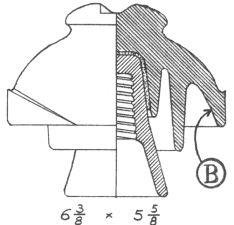Porcelain Insulator News
by Jack H. Tod, NIA #13
Reprinted from "INSULATORS - Crown Jewels of the Wire", December 1983, page 23
Dear Jack:
It's hard to find any
porcelain goodies where I'm located here in Oregon, but my luck changed recently
when I bought at a secondhand store one of the old insulators with the eaves
around the outer edge of the skirt. The shop owner told me it was Canadian., but
didn't offer any other information on it. When I got home with it, I was able to
find the insulator mentioned in your column of November 1974, and again in the September
1978 issue of CJ.

The insulator matches the specimen from California, except
that the circle-B stamp is on the inside of the outer petticoat, and it appears
only once. How they managed to stamp the circle-B marking on the inside of the
outer shell is beyond me! The white glaze extends all the way into the
flat-topped pin hole. Only the bases of the inner two petticoats are unglazed,
and it appears that the glaze was fettled off these surfaces before firing,
either with sandpaper or some other abrasive.
Have you discovered any other
information on these insulators since your September 1978 article? Incidentally,
I paid $5.00 for this jewel!
Mark Willke
Silverton, Oregon
- - - - - - - - - -
Dear Mark:
No, I
haven't heard more about one of these other than the one in 1974 and the
material from the 1904 report indicating its possible foreign origin, most
probably from a European manufacturer, circa 1900.
The fact that you say the
inner petticoats have a firing rest is a pretty good indication that it was made
by glazewelding of several shells together. Your insulator's style resembles
insulators made in the late 1890's, and all such large insulators made then were
made by glazewelding shells.
If it indeed was a glazeweld, it is understandable
that the circle-B marking could have easily (and normally) been applied to the
inside of the outer shell. Furthermore, this was par for the course on many
items as a device for indicating different part sizes (for stocking purposes)
when they were later assembled.
By the way, even though we don't know the origin
(foreign?) of this insulator, I'd still say it is a good item due to its obvious
antiquity. A super wild guess as to its value at a large insulator show would be
$150 to $300. Your $5 purchase price would seem to fall in the bargain category.
Jack
NEW BOOK.
Collectible Porcelain Insulators, Third Edition, by Gerald Brown, 1983,
8-1/2" x 11", 262 pages, $18 postpaid from Gerald at Box 1, Two
Buttes, CO 81084.
This book was reviewed in detail on page 30 of October 1983
Crown Jewels. I wish to personally echo that favorable review in this column.
Getting all this information under a single cover was a gigantic undertaking for
Gerald. He and I agree that a task such as that seems similar to that of giving
birth to and raising quintuplets! All collectors who maintain a library of the
better insulator reference books should obtain this new one.
Jack
For what it's
worth, here is more complete information, in fragmental form, on the RACO //
DEAD END insulator mentioned on page 28 of the May 1983 CJ, and specimens of
which are in numerous collections.
Ken Schumacher advised in 1973 that these
were a product of Raco Electrical Products Division of All Steel Company,
Aurora, Illinois, and this is the attribution I listed for the RACO marking in
my 1977 "Electrical Porcelain" book.
Per a 1921 directory listing in
my files, this company in Aurora was listed as "All Steel Equipment
Co." a manufacturer of cutout (fuse) boxes and cabinets.
Steven Jones
(Conn.) advised last summer that the 1982 Thomas Register lists Raco, Inc. as a
manufacturer of communications equipment and is located in South Bend, Ind.
At
least one of the makers of the RACO porcelain strains was Thomas, since I found
specimens of these in the Thomas dumpage at Lisbon, Ohio in 1973, and they
carried the "T" marking used by Thomas on contract items.
| 